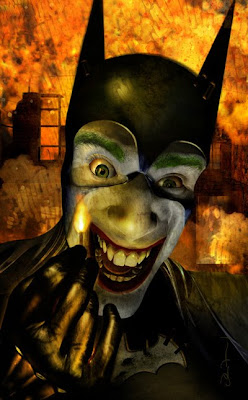Eiko Chan tumblr
Eiko Chan on deviantART
Eiko Chan on Blogspot


























































 The second chapter is about preparation and has as much to do with seeing others and seeing yourself as it does with not letting others see your true self. After second (this one is the last) fake sounding story about ninja practices, the book talks about getting over your own stereotypes and seeing people and remember very specific details. The exercises he suggests throughout this chapter sound very valuable to someone trying to emulate the world’s greatest detective and throughout the next month I am determined to practice some of them. I’ll introduce as they come up in later posts. After practising to see others, the book then says you should apply this to yourself. Identify your own stereotype. Only once you know what kind of person you project to others can you make alterations to that projection.
The second chapter is about preparation and has as much to do with seeing others and seeing yourself as it does with not letting others see your true self. After second (this one is the last) fake sounding story about ninja practices, the book talks about getting over your own stereotypes and seeing people and remember very specific details. The exercises he suggests throughout this chapter sound very valuable to someone trying to emulate the world’s greatest detective and throughout the next month I am determined to practice some of them. I’ll introduce as they come up in later posts. After practising to see others, the book then says you should apply this to yourself. Identify your own stereotype. Only once you know what kind of person you project to others can you make alterations to that projection. Beyond those points the main points of this third chapter can be summarized pretty clearly:
Beyond those points the main points of this third chapter can be summarized pretty clearly: The next chapter is basically about acting. There’s a couple of important points here. Firstly, don’t try to pass yourself off as a member of any group that you are trying to infiltrate. There are just too many details and subtleties to trip you up. Instead be as different as possible and rely on their stereotypes to help your disguise. Secondly, learn to be quiet. It is an amateur mistake to give lots of made-up background. Don’t babble. Shut up. Be confident in your disguise. People don’t generally care about you and if they are asking it is probably just polite and they won’t expect concrete responses so don’t give them concrete response. The book quotes President Coolidge as saying, “If you don’t say anything, you won’t be called upon to repeat it,” and also, “I never got in trouble for anything I didn’t say.” But this has to be done with tact because if you only ask questions and never reveal anything about yourself (i.e. the character you are disguised as) then people will feel like you are interrogating them and grow distrustful. The solution: learn to flimflam. Small talk is super easy, and so is saying words without any meaning. All it takes is a little practice.
The next chapter is basically about acting. There’s a couple of important points here. Firstly, don’t try to pass yourself off as a member of any group that you are trying to infiltrate. There are just too many details and subtleties to trip you up. Instead be as different as possible and rely on their stereotypes to help your disguise. Secondly, learn to be quiet. It is an amateur mistake to give lots of made-up background. Don’t babble. Shut up. Be confident in your disguise. People don’t generally care about you and if they are asking it is probably just polite and they won’t expect concrete responses so don’t give them concrete response. The book quotes President Coolidge as saying, “If you don’t say anything, you won’t be called upon to repeat it,” and also, “I never got in trouble for anything I didn’t say.” But this has to be done with tact because if you only ask questions and never reveal anything about yourself (i.e. the character you are disguised as) then people will feel like you are interrogating them and grow distrustful. The solution: learn to flimflam. Small talk is super easy, and so is saying words without any meaning. All it takes is a little practice.It seems like forever ago that I last posted. What have I been doing for a week?
 Reading up on disguise techniques, that’s what. Since my last post I’ve read through a short book called “Disguise Techniques-Fool All of the People Some of the Time” by Ed MacInaugh. It’s actually a great book and I would recommend it to anyone with even a passing interest in disguises. I was really worried for awhile that I wouldn’t find useful information on the topic but this book was a great introduction and I’d like to recap it for you.
Reading up on disguise techniques, that’s what. Since my last post I’ve read through a short book called “Disguise Techniques-Fool All of the People Some of the Time” by Ed MacInaugh. It’s actually a great book and I would recommend it to anyone with even a passing interest in disguises. I was really worried for awhile that I wouldn’t find useful information on the topic but this book was a great introduction and I’d like to recap it for you.
The book is made up of 5 chapters and a conclusion. The first chapter talks about the psychology needed to become invisible, the second chapter (definitely my favorite chapter) preps you for taking up a disguise, the third talks about disguises, the fourth about acting and the fifth about makeup. Please I beg you, if you ever pickup this book, make it through the terrible Introduction and the start of the first chapter. The Introduction centers around a useless cartoon picture about stereotypes and the first chapter starts off with a bunch of hokey sounding stuff like “Not-being is a state of mind. It could be described as the antithesis of ‘be here now.’ You have probably practiced not being…” But it does get better (after the terribly painful paragraph about Ninja training and an intuitive sense of scrutiny).
Tomorrow I'll post a synopsis of the chapters.
 In the mean time, let me introduce you to another person who is famous for being masters of disguise:
In the mean time, let me introduce you to another person who is famous for being masters of disguise: Emma continued to use Cuff as her disguise but also developed a black mammy laundress. Once while cleaning an officer's coat, she found a bundle of official documents in one of the pockets full of important information. She was also involved in setting up a spy network in Louisville disguised as southerner Charles Mayberry.
Emma continued to use Cuff as her disguise but also developed a black mammy laundress. Once while cleaning an officer's coat, she found a bundle of official documents in one of the pockets full of important information. She was also involved in setting up a spy network in Louisville disguised as southerner Charles Mayberry.



























